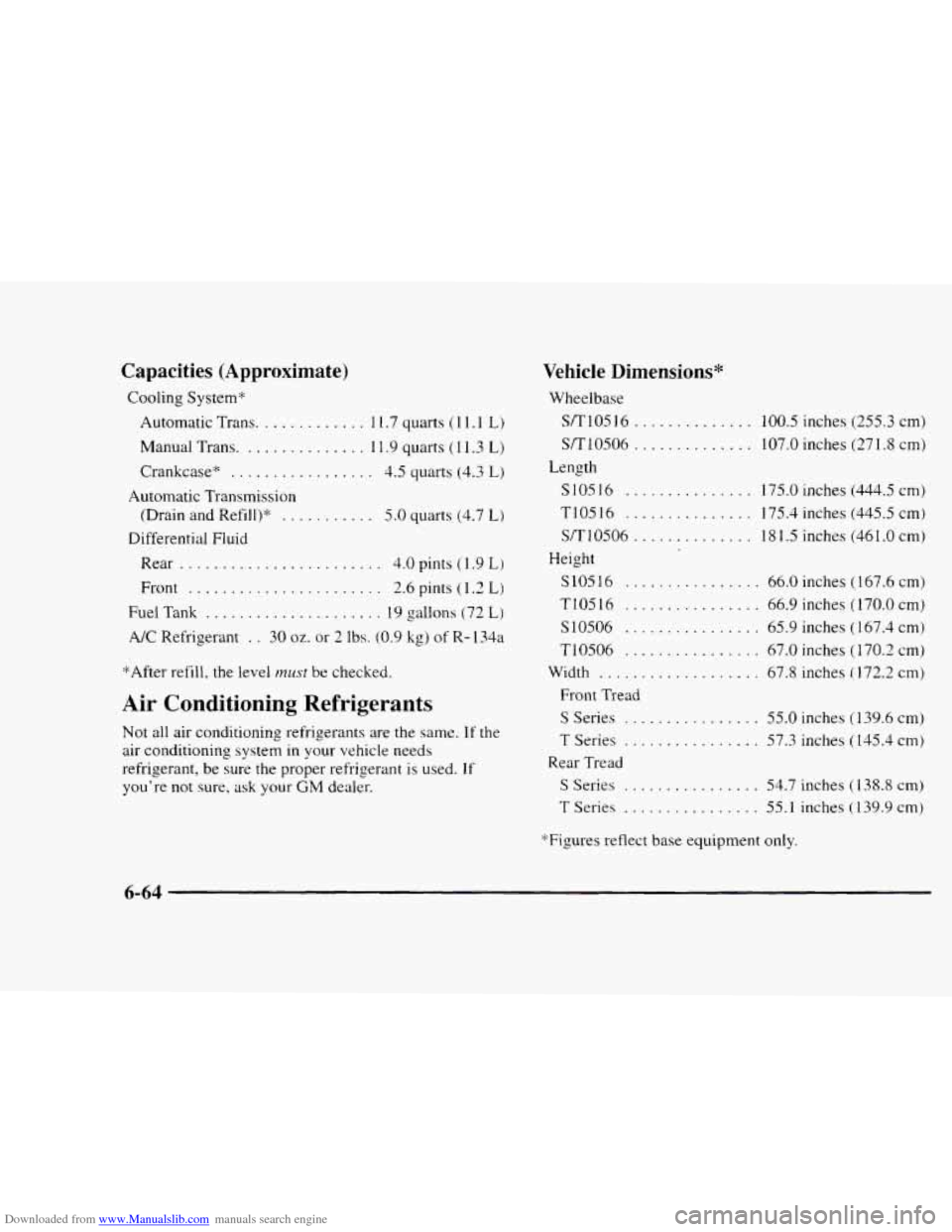Page 164 of 402

Downloaded from www.Manualslib.com manuals search engine Drunken Driving
Death and injury associated with drinking and driving is
a national tragedy. It’s the number one contributor to the
highway death
toll, claiming thousands of victims
every year.
Alcohol affects four things
that anyone needs to drive
a vehicle:
0 Judgment
0 Muscular Coordination
0 Vision
0 Attentiveness.
Police records show that almost half
of all motor
vehicle-related deaths involve alcohol.
In most cases,
these deaths are
the result of someone who was drinking
and driving. In recent years, some
17,000 annual motor
vehicle-related deaths have been associated with the use
of alcohol, with more than 300,000 people injured.
Many adults
-- by some estimates, nearly half the adult
population
-- choose never to drink alcohol, so they
never drive after drinking. For persons under
2 1, it’s
against the law
in every U.S. state to drink alcohol.
There are good medical, psychological and
developmental reasons for these laws.
The obvious way to solve this highway safety problem
is for people never to drink alcohol and then drive. But
what
if people do? How much is “too much” if the
driver plans
to drive? It’s a lot less than many might
think. Although it depends
on each person and situation,
here
is some general information on the problem.
The Blood Alcohol Concentration (BAC)
of someone
who is drinking depends upon four things:
The amount of alcohol consumed
0 The drinker’s body weight
0 The amount of food that is consumed before and
during drinking
0 The length of time it has taken the drinker to
consume the alcohol.
According to
the American Medical Association, a
180-lb. (82 kg) person who drinks three 12-ounce
(355 ml) bottles of beer in an hour will end up with a
BAC of about 0.06 percent. The person would reach the
same BAC
by drinking three 4-ounce ( 120 ml) glasses
of wine or three mixed drinks if each had
1 - 1/2 ounces
(45 ml) of a liquor like whiskey, gin or vodka.
4-3
Page 185 of 402

Downloaded from www.Manualslib.com manuals search engine Q: Am I likely to stall when going downhill?
A: It’s much more likely to happen going uphill. But if
it happens going downhill, here’s what to do.
0 Stop your vehicle by applying the regular brakes.
Shift to PARK (P) (or to NEUTRAL (N) with the
Apply the parking brake.
nlanual
transmission) and, while still brakin,,
0 restart
the engine.
and drive straight down.
Shift back to a low gear. release the parking brake,
If the engine won’t start, get out and get help.
Driving Across an Incline
Sooner or later, an off-road trail will probably go across
the incline of a hill. If this happens, you have to decide
whether
to try to drive across the incline. Here are some
things
to consider:
0 A hill that can be driven straight up or down may be
too steep to drive across. When you
go straight up or
down
a hill. the length of the wheel base (the
distance from the front wheels
to the rear wheels)
reduces the likelihood
the vehicle will tumble end
over end.
But when you drive across an incline, the
much more narrow track width (the distance between
the left and
right wheels) may not prevent the vehicle
0
0
from tilting and rolling over. Also, driving across an
incline puts more weight
on the downhill wheels.
This could cause
a downhill slide or a rollover.
Surface conditions can be
a problem when you drive
across
a hill. Loose gravel. muddy spots, or even wet
If the vehicle slips sideways. it can hit something
that
will trip it (a rock. a rut, etc.) and roIl over.
Hidden obstacles can make the steepness
of the
incline even worse. If you drive across a rock with
the uphill wheels, or if the downhill wheels drop into
a rut or depression, your vehicle can tilt even more.
2 orass can cause your tires to slip sideways. downhill.
For reasons like these, you need
to decide carefully whether
to try to drive across 31 incline. Just because the trail goes
;lcross the incline doesn’t mean you have to drive it. The
last vehcle
to try it might have rolled over.
A CAUTION:
Driving across an incline that’s too steep will
make your vehicle roll over. You could be
seriously injured or killed.
If you have any doubt
about the steepness
of the incline, don’t drive
across it. Find another route instead.
A
4-24
Page 319 of 402

Downloaded from www.Manualslib.com manuals search engine Capacities (Approximate)
Cooling System* Automatic Trans.
............ 1 1.7 quarts ( 1 I. 1 L)
Manual Trans. .............. 1 1.9 quarts ( 1 1.3 L)
Crankcase* ................. 4.5 quarts (4.3 L)
Automatic Transmission
(Drain and Refill)"
........... 5.0 quarts (4.7 L)
Differential Fluid
Rear
........................ 4.0 pints (1.9 L)
Front ....................... 2.6 pints (1.2 L)
Fuel Tank ..................... 19 gallons (72 L)
A/C Refrigerant . . 30 oz. or 2 lbs. (0.9 kg) of R- 134a
*After refill, the level
must be checked.
Air Conditioning Refrigerants
Not all air conditioning refrigerants are the same. If the
air conditioning system in your vehicle needs
refrigerant, be sure the proper refrigerant
is used. If
you're not sure, ask your GM dealer.
Vehicle Dimensions*
Wheelbase
S/T10516 .............. 100.5 inches (255.3 cm)
1 S/T10506 .............. 107.0 .
Length
S10516 ............... 175.0
T10516 ............... 175.4 nches
(27 I .8 cm)
nches (444.5 cm)
nches (445.5 cm)
S/T 10506 .............. 18 I .5 inches (46 I .O cm)
Height
S10516 ................ 66.0 inches (167.6 cm)
T10516
................ 66.9 inches (170.0cm)
S10506
................ 65.9 inches (167.4 cm)
T10506
................ 67.0 inches (170.2 cm)
Width
....... .......... 67.8 inches ( 172.2 cm)
Front Tread
S Series ................ 55.0 inches (139.6 cm)
T Series ................ 57.3 inches (145.4 cm)
S Series ................ 54.7 inches (138.8 cm)
T Series ................ 55.1 inches ( 139.9 cm)
Rear Tread
*Figures reflect base equipment only.
6-64